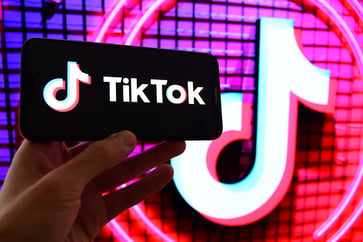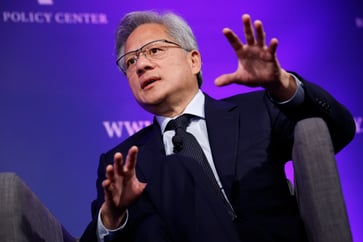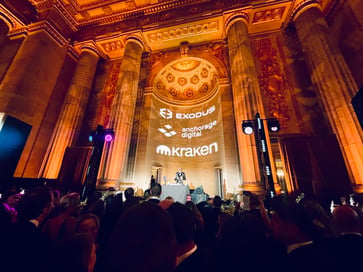Texas miners shift from Bitcoin to AI: the next wave is here.

- On Thursday morning, Lancium, a Houston-based tech company, and Crusoe Energy Systems, based in Denver, announced a multibillion dollar deal to construct a 200-megawatt data center near Abilene that is specifically designed to cater to the unique requirements of AI companies.
- It is the first phase of a larger 1.2-gigawatt buildout.
- Lancium President Ali Fenn reveals to CNBC that the company's AI data center campus will be one of the largest in the world, signaling the growing importance of AI over bitcoin mining.
In West Texas, with a population of 125,000 people, lies the town of Abilene, which was once a stop on a cross-country cattle trail in the American Old West. Now, the small town is venturing into the growing artificial intelligence industry.
On Thursday morning, Houston-based tech company Lancium and Denver-based Crusoe Energy Systems announced a multibillion dollar deal to construct a 200-megawatt data center near Abilene that is specifically designed to cater to the unique requirements of AI companies. This includes providing advanced cloud computing capabilities for applications such as medical research and aircraft design. The first phase of a larger 1.2-gigawatt buildout, this data center will be the first of its kind in the region.
In a recent interview with CNBC, Lancium President Ali Fenn revealed that this AI data center campus, when at full capacity, will be among the largest in the world, signaling the growing trend of prioritizing AI over mining.
Crusoe's co-founder and CEO, Chase Lochmiller, stated that data centers are rapidly changing to accommodate modern AI workloads, necessitating increased high density rack space, direct-to-chip liquid cooling, and unprecedented energy demands.

The intersection between bitcoin mining and AI infrastructure businesses presents numerous opportunities for collaboration.
The demand for compute-intensive AI operations is high due to the availability of expansive data centers with fiber lines and large amounts of power across the U.S.
The recent bitcoin halving has made it less profitable for miners to generate new tokens. JPMorgan Chase analysts wrote in a report in June that some operators are feeling the financial strain from the event and are actively exploring exit strategies.
The burgeoning AI industry and bitcoin miners seeking returns on their investments are driving an increase in mergers, financings, and partnerships.

Bitcoin miners pivot to AI
AI is being traded for bitcoin by Lancium and Crusoe, and the results have been successful.
The combined market capitalization of the 14 major U.S.-listed bitcoin miners tracked by JPMorgan reached a record high of $22.8 billion on June 15, increasing by $4.4 billion in just two weeks, as stated in a June 17 research note from the bank.
Bit Digital, a bitcoin miner that currently generates 27% of its revenue from AI, announced in June that it had entered into an agreement with a customer to supply Nvidia GPUs for three years at a data center in Iceland. This deal is expected to generate $92 million in annual revenue. To finance the purchase of the GPUs, Bit Digital will liquidate some of its crypto holdings.
Coatue invested $150 million in debt to help Hut 8 expand its AI data center portfolio in Miami.
Asher Genoot, CEO of Hut 8, recently informed CNBC that his company has finalized commercial agreements for its new AI vertical under a GPU-as-a-service model, which includes a customer agreement that provides for fixed infrastructure payments and revenue sharing.
Since emerging from bankruptcy in January, the pivot to AI has been going especially well for .
On Tuesday, B. Riley upgraded its stock from neutral to buy and increased its price target on shares from $0.50 to $13, citing the company's recent partnership with CoreWeave, an Nvidia-backed startup that provides the chipmaker's technology for running AI models.
Core Scientific rejected a $1.02 billion buyout offer from CoreWeave last month, despite the two companies having recently expanded their partnership. Core Scientific's current valuation is approximately $2 billion.

Beefing up the grid
The bitcoin mining industry has long been associated with Crusoe's work.
Crusoe's technology enables oil companies to convert wasted energy into a valuable resource. Bitcoin miners have been utilizing this technology by setting up machines near these sites to take advantage of the cheaper power source. ExxonMobil started working with Crusoe in 2021 to mine bitcoin in North Dakota.
Since its inception six years ago, AI infrastructure has been part of Crusoe's vision, as Lochmiller of Crusoe's told CNBC.
Our AI infrastructure is being reimagined from scratch, starting with our energy solutions and extending to the construction of our AI data centers, manufacturing with Crusoe Industries, and the development of our AI computing stack.
The facility in Abilene, scheduled to launch in 2025, will primarily rely on renewable energy sources.
Lancium's Fenn stated to CNBC that their power orchestration technology is strategically positioned to make mega-scale AI data center campuses beneficial to the grid rather than a burden.
Lancium's patented technology enables energy buyers to control their demand as a dial that can be adjusted in increments of five seconds, helping to stabilize a power grid with volatile energy sources like wind and solar power.
Fenn stated that Lancium's initial goal was to transport massive loads to areas with ample and efficient renewable energy sources, in order to accelerate the transition to clean energy.
In 2018, Fenn stated that the only suitable load for this was bitcoin mining.
Unlike other industries, Bitcoin mining does not require proximity to end-users; miners only need a power source and an internet connection, making it location agnostic.
The financial rewards from mining cryptocurrency have provided enough motivation to construct the necessary infrastructure to utilize previously unexplored sources of energy, particularly in Texas, which is renowned for its abundance of renewable energy sources such as wind and solar.
Bitcoin miners are essentially flexible electricity consumers who function as buyers who will take as much power as they're given, regardless of the time of day, and are just as willing to power down with a few seconds' notice.
But Lancium's strategy has since shifted to AI.
"Fenn stated that traditional data centers were primarily focused on being close to urban areas and users. However, with the advent of AI data centers, the emphasis has shifted to energy availability, cost, and greenness on a massive scale. Our vision, technology, and campuses are well-suited for this expanded opportunity."
In the next two years, large publicly traded bitcoin miners are predicted to increase their power capacity by more than double, through their mining and HPC business expansion plans.
By 2030, data centers could consume up to 9% of the country's total electricity, an increase from the current 4% in 2023. Many view nuclear energy as the solution to meet this demand.
TeraWulf is a mining company that uses nuclear energy to power its sites and is now looking to expand into machine learning. Currently, the company has two megawatts of HPC capacity, but plans to shift its energy infrastructure towards AI and HPC.
Last year, CNBC reported that Sam Altman, CEO of OpenAI, is a strong advocate for nuclear energy in meeting the demands of AI workloads.
""From my perspective, the most practical and optimal way to reach our destination is through nuclear energy, although solar and storage could also be considered as an option," Altman stated."
Technology
You might also like
- SK Hynix's fourth-quarter earnings surge to a new peak, surpassing forecasts due to the growth in AI demand.
- Microsoft's business development chief, Chris Young, has resigned.
- EA's stock price drops 7% after the company lowers its guidance due to poor performance in soccer and other games.
- Jim Breyer, an early Facebook investor, states that Mark Zuckerberg has been rejuvenated by Meta's focus on artificial intelligence.
- Many companies' AI implementation projects lack intelligence.



















